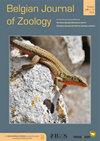动物化学通讯的进化:来自非模式物种和系统发育比较方法的见解
IF 1.3
4区 生物学
Q2 ZOOLOGY
引用次数: 16
摘要
化学通讯可能是自然界中最古老、最普遍的信息交换形式,跨越了生命的所有三个领域。虽然对动物化学信号的形式和功能进行了出色的社会生物学和行为生态学研究,但我们对它们的进化知之甚少。此外,我们对化学信号多样性的了解大多局限于昆虫,因为对脊椎动物化学通讯的研究相对较少。本文介绍了动物通讯的主要概念,并对化学通讯研究的过去、现在和未来进行了展望。在此过程中,我强调了目前我们在动物化学通讯系统进化方面的知识差距,同时强调了对鳞翅目动物的严重研究偏见。在这里,我详细介绍了使用系统发育比较方法来识别引导化学信号和化学感觉系统进化的马达和制动器的好处。此外,我指出,关注化学生态学中的非模式物种,特别是蜥蜴,可以提供有价值的见解,了解脊椎动物化学信号是如何进化的,以及负责发送和接收信号的生物系统是如何与信号设计共同进化的。最后,我提出了一个关于蜥蜴的案例研究,展示了系统发育比较方法和使用非模式物种来研究动物化学通讯系统进化的可能性。本文章由计算机程序翻译,如有差异,请以英文原文为准。
Evolution of animal chemical communication: Insights from non-model species and phylogenetic comparative methods
Chemical communication is probably the oldest, most ubiquitous form of information exchange in the natural world, spanning all three domains of life. While excellent sociobiological and behavioral ecological research has been conducted on the form and function of chemical signals in animals, we still know remarkably little on their evolution. Besides, much of our understanding of chemical signal diversity is restricted to insects, since studies on chemical communication in vertebrates are relatively scarce. In this review, I introduce the key concepts of animal communication and expand on the past, present, and future of research in chemical communication. When doing so, I highlight the current gaps in our knowledge on the evolution of the chemical communication system in animals, whilst emphasizing the heavy research bias towards lepidopterans. Here, I detail the benefits of using phylogenetic comparative methods to identify the motors and brakes that guide the evolution of chemical signals and chemical sensory systems. Moreover, I point out that focusing on non-model species in chemical ecology, specifically lizards, can provide valuable insights into how vertebrate chemical signals evolve, and how biological systems responsible for sending and receiving signals co-evolve with signal design. Lastly, I present a case study on lacertid lizards, demonstrating the possibilities of the phylogenetic comparative approach and the use of non-model species to study the evolution of animal chemical communication systems.
求助全文
通过发布文献求助,成功后即可免费获取论文全文。
去求助
来源期刊

Belgian Journal of Zoology
生物-动物学
CiteScore
1.90
自引率
0.00%
发文量
10
审稿时长
>12 weeks
期刊介绍:
The Belgian Journal of Zoology is an open access journal publishing high-quality research papers in English that are original, of broad interest and hypothesis-driven. Manuscripts on all aspects of zoology are considered, including anatomy, behaviour, developmental biology, ecology, evolution, genetics, genomics and physiology. Manuscripts on veterinary topics are outside of the journal’s scope. The Belgian Journal of Zoology also welcomes reviews, especially from complex or poorly understood research fields in zoology. The Belgian Journal of Zoology does no longer publish purely taxonomic papers. Surveys and reports on novel or invasive animal species for Belgium are considered only if sufficient new biological or biogeographic information is included.
 求助内容:
求助内容: 应助结果提醒方式:
应助结果提醒方式:


